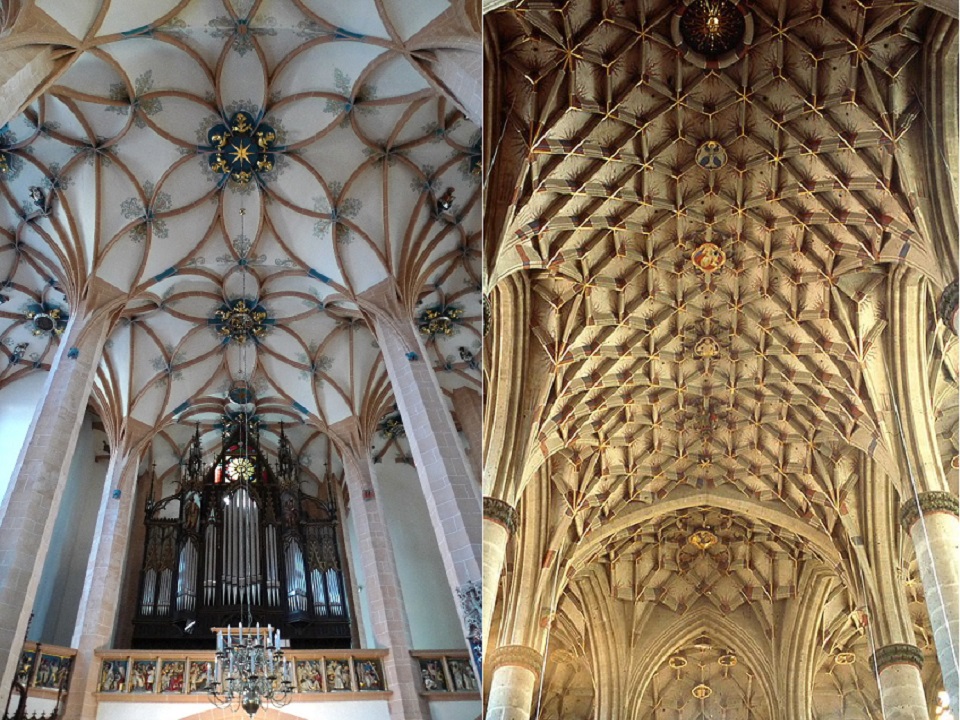Sondergotik


Sondergotik (Special Gothic) is the style of Late Gothic architecture prevalent in Austria, Bavaria, Saxony and Bohemia between 1350 and 1550. The term was invented by art historian Kurt Gerstenberg in his 1913 work Deutsche Sondergotik, in which he argued that the Late Gothic had a special expression in Germany (especially the South and the Rhineland) marked by the use of the hall church or Hallenkirche. At the same time the style forms part of the International Gothic style in its origins.
The style was contemporaneous with several unique local styles of Gothic: the flamboyant in France, the perpendicular in England, the Manueline in Portugal, and the Isabelline in Spain. Like these, the Sondergotik showed an attention to detail both within and without. In many Sondergotik buildings, fluidity and a wood-like quality were stressed in carving and decoration, particularly on vaults. The rib patterns of Sondergotik vaults are elaborate and often curved (in plan), sometimes using broken and flying ribs (features extremely rare in other regions). Outside, the buildings tended towards mass buttressing.
Among the most famous Sondergotik constructions is Saint Barbara Church in Kutná Hora (modern Czech Republic), built by the Parlers, a family of masons.
Description
The Gothic architecture in Germany is distinguished from elements that, in France , praying in Gothic, are necessarily unusual. It distinguishes itself from the French models and their system, and by means of reductions, and also by means of plugins.
In the architecture of the pillows , but also outside of it has been abandoned in various countries in Europe on the introduction and further development of the Gothic in the elements of a complete cathedral construction. This reducing Gothic style has spread around 1300 and has created certain preconditions for the Gothic architecture in Germany . To the reductions it belongs to the excavation of a corridor , an absidewaters and triforium , in addition, after the construction of the cathedrals in Strasbourg and Cologne, as well as decorations, the capitals do not exist at all. The use of simple round or eyelid backbacks instead of complicated cascade cells makes the appearance cool. The adaptation of the height of the sideways to the mainstream , that is to say, the development of a hallway with its spacious, balanced interior creates a new space space that appears as an alternative to the basement cathedral building. As tops are the halls of Annaberg and Schneeberg in Saksujo as well as Dinkelsbühl and Nördlingen in Bavaria .
Unlike Gothic cathedrals in France, the German parish church buildings are uniquurable. The turmoil construction increasingly and more striking is a distinction of a particular German development. Enrichments are mainly found in the post-lagoon. They are particularly concerned with the increasingly complex forms of vaults , baskets and ribs. Typical are star, net and masovolves, as well as sowie spiral pilasters.
The German gothic buildings are encompassable:
hawkers
paddle churches with a basilic scheme
brick buildings
As long as in the north of Germany the nave is located under single roofs, in Bavaria and Baden-Württemberg a single roof covers the whole church.
Characteristic
The German special gothic is characterized by elements that are quite uncommon in France , the country of origin of the Gothic. It differs from the French models and their system both through reductions and enrichments.
In the construction of the mendicant orders , but also outside of these, in many countries of Europe, the introduction and further development of the gothic originating in France is being renounced in many places on elements of complete cathedral construction. This style of expression, described by German art historians ( Georg Dehio ) as a ” reduction gothic ” spreads around 1300 and creates certain conditions for the German special gothic. The reductions include the elimination of ambulatory , chapel wreath and Triforium , also is waived (after the construction of the Strasbourg Cathedral and the Cologne Cathedral ) on the Wimperge . Capitals are missing completely. The use of simple round or octagonal columns instead of complicated bundle pillars calms the appearance.
The adaptation of the height of the aisles to the nave , that is, the development of the hall church with its wide, balanced interior creates a new type of space, which appears as an alternative to basilikale cathedral construction.
The twin towers of the bishop churches, which are common in France, face the inlaid towers of the city parish churches . The ever-increasing tower is considered a special feature of German development. Enrichments occur especially in late Gothic. In particular, they concern the increasingly complicated forms of vaults , services and ribs. Typical are star, net and Schlinggewölbe as well as spiral-shaped pillars.
Division
The buildings classified in the German special gothic can be divided into three groups:
Hall churches
Bettelordenskirchen (according to the basilical scheme)
brick buildings
While in North Germany the naves are under individual roofs, in Bavaria and Baden-Württemberg the entire church is covered by a single roof.
Although Gerstenberg’s thesis of a special gothic indoor space as an epochal special achievement of a Germanic “race” is long since recognized as one-sided and socio-historically wrong , the term went into the vocabulary of late gothic research, without being critically scrutinized.
Source From Wikipedia